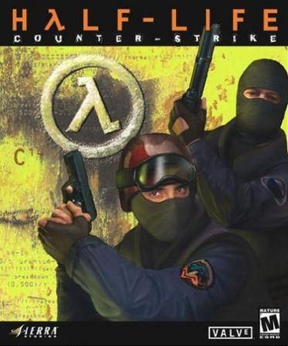
Counter-Strike is a tactical first-person shooter game developed by Valve. It was initially developed and released as a Half-Life modification by Minh "Gooseman" Le and Jess Cliffe in 1999, before Le and Cliffe were hired and the game's intellectual property acquired. Counter-Strike was released by Valve for Microsoft Windows in 2000, and is the first installment in the Counter-Strike series. Several remakes and ports were released on Xbox, as well as OS X and Linux.

Deus Ex is a 2000 action role-playing game developed by Ion Storm and published by Eidos Interactive. Set in a cyberpunk-themed dystopian world in the year 2052, the game follows JC Denton, an agent of the fictional agency United Nations Anti-Terrorist Coalition (UNATCO), who is given superhuman abilities by nanotechnology, as he sets out to combat hostile forces in a world ravaged by inequality and a deadly plague. His missions entangle him in a conspiracy that brings him into conflict with the Triads, Majestic 12, and the Illuminati.

Doom is a 1993 first-person shooter (FPS) game developed by id Software for MS-DOS. Players assume the role of a space marine, popularly known as Doomguy, fighting their way through hordes of invading demons from hell. id began developing Doom after the release of their previous FPS, Wolfenstein 3D (1992). It emerged from a 3D game engine developed by John Carmack, who wanted to create a science fiction game inspired by Dungeons & Dragons and the films Evil Dead II and Aliens. The first episode, comprising nine levels, was distributed freely as shareware; the full game, with two further episodes, was sold via mail order. An updated version with an additional episode and more difficult levels, The Ultimate Doom, was released in 1995 and sold at retail.

Rise of the Triad: Dark War is a first-person shooter video game, developed and published by Apogee Software in 1995. The player can choose one of five different characters to play as, each bearing unique attributes such as height, speed, and endurance. The game's story follows these five characters who have been sent to investigate a deadly cult, and soon become aware of a deadly plot to destroy a nearby city. Its remake was designed by Interceptor Entertainment and released by Apogee Games in 2013. The shareware version of the game is titled Rise of the Triad: The HUNT Begins.
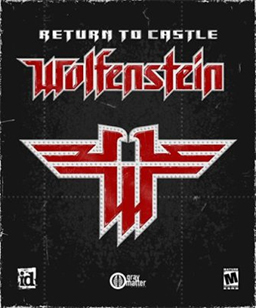
Return to Castle Wolfenstein is a first-person shooter video game published by Activision, released on November 20, 2001, for Microsoft Windows and subsequently for PlayStation 2, Xbox, Linux and Macintosh. The game serves as a reboot of the Wolfenstein series. It was developed by Gray Matter Studios and Nerve Software developed its multiplayer mode. id Software, the creators of Wolfenstein 3D, oversaw the development and were credited as executive producers. The multiplayer side eventually became the most popular part of the game, and was influential in the genre. Splash Damage created some of the maps for the Game of the Year edition. A sequel, titled Wolfenstein, was released on August 18, 2009.
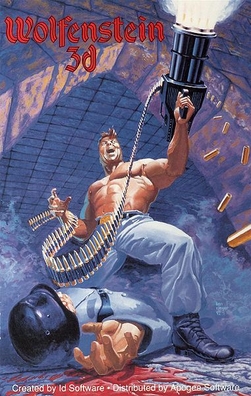
Wolfenstein 3D is a first-person shooter video game developed by id Software and published by Apogee Software and FormGen. Originally released on May 5, 1992, for DOS, it was inspired by the 1981 Muse Software video game Castle Wolfenstein, and is the third installment in the Wolfenstein series. In Wolfenstein 3D, the player assumes the role of Allied spy William "B.J." Blazkowicz during World War II as he escapes from the Nazi German prison Castle Wolfenstein and carries out a series of crucial missions against the Nazis. The player traverses each of the game's levels to find an elevator to the next level or kill a final boss, fighting Nazi soldiers, dogs, and other enemies with knives and a variety of guns.
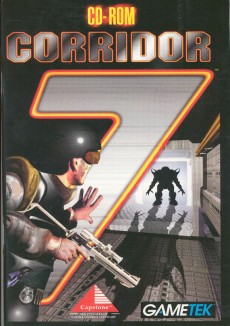
Corridor 7: Alien Invasion is a first-person shooter video game developed by Capstone Software and published by IntraCorp and GameTek. It was poorly received, largely due to its use of the outdated Wolfenstein 3D engine, which was technologically inferior to the Doom engine, which was available at the time. A sequel, Corridor 8: Galactic Wars, was in development, but later cancelled.

The Iranian Embassy siege took place from 30 April to 5 May 1980, after a group of six armed men stormed the Iranian embassy on Prince's Gate in South Kensington, London. The gunmen, Iranian Arabs campaigning for sovereignty of Khuzestan Province, took 26 people hostage, including embassy staff, several visitors, and a police officer who had been guarding the embassy. They demanded the release of prisoners in Khuzestan and their own safe passage out of the United Kingdom. The British government quickly decided that safe passage would not be granted and a siege ensued. Subsequently, police negotiators secured the release of five hostages in exchange for minor concessions, such as the broadcasting of the hostage-takers' demands on British television.
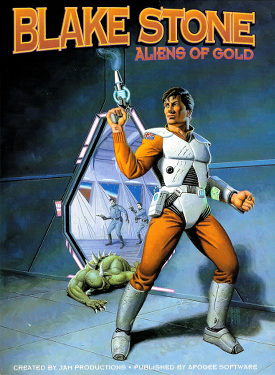
Blake Stone: Aliens of Gold is a first-person shooter for DOS created by JAM Productions and published by Apogee Software on December 5, 1993. The following year, a sequel called Blake Stone: Planet Strike was released, which continues where Aliens of Gold leaves off. Some copies of the game provided a Command Control Gravis Gamepad.

James Bond 007: Nightfire is a 2002 first-person shooter video game published by Electronic Arts for the GameCube, PlayStation 2, Xbox and Microsoft Windows, with additional versions released for the Game Boy Advance in 2003, and the Mac OS X in 2004. The computer versions feature modifications to the storyline, different missions and the removal of driving sections used in home console versions.

SWAT 3: Close Quarters Battle is a 1999 tactical first-person shooter video game developed by Sierra Northwest and published by Sierra Entertainment exclusively for Microsoft Windows. It is the seventh installment of the Police Quest series and the third installment in the SWAT subseries. SWAT 3 follows the Los Angeles Police Department Metropolitan Division SWAT team as they combat a wave of violent crime and terrorism in Los Angeles in the lead-up to a nuclear disarmament treaty signing.
Doom, a first-person shooter game by id Software, was released in December 1993 and is considered one of the most significant and influential titles in video game history. Development began in November 1992, with programmers John Carmack and John Romero, artists Adrian Carmack and Kevin Cloud, and designer Tom Hall. Late in development, Hall was replaced by Sandy Petersen and programmer Dave Taylor joined. The music and sound effects were created by Bobby Prince.

Delta Force: Land Warrior is a tactical first-person shooter video game. It is the third game in the Delta Force series developed and published by NovaLogic, and is the sequel to Delta Force 2. A stand-alone expansion pack, Delta Force: Task Force Dagger, was released in 2002.

ShadowCaster is a first-person role-playing video game developed by Raven Software. It was published in 1993 by Origin Systems after Electronic Arts acquired them. A CD-ROM version was released in 1994, featuring two additional levels with new monsters, and replacing text boxes with FMVs and spoken narration through CD-DA audio tracks.
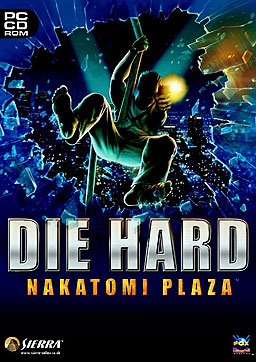
Die Hard: Nakatomi Plaza is a first-person shooter video game developed by Piranha Games and published by Vivendi Universal Games and its subsidiary Sierra Entertainment exclusively for Microsoft Windows. The game originally used a modified Build engine, later the GoldSrc engine, before it was finally moved to the Lithtech engine. The game features the voice of Reginald VelJohnson, reprising his role as Al Powell.
Wolfenstein is a series of World War II video games originally developed by Muse Software. The majority of the games follow William "B.J." Blazkowicz, an American Army captain, and his fight against the Axis powers. Earlier titles are centered around Nazis attempting to harness supernatural and occult forces, while later games are set in an alternate history in which Axis powers won World War II.

id Tech is a series of separate game engines designed and developed by id Software. Prior to the presentation of the id Tech 5-based game Rage in 2011, the engines lacked official designation and as such were simply referred to as the Doom and Quake engines, from the name of the main game series the engines had been developed for. "id Tech" has been released as free software under the GNU General Public License. id Tech versions 0 to 3 were released under GPL-2.0-or-later. id Tech versions 3.5 to 4.5 were released under GPL-3.0-or-later. id Tech 5 to 7 are proprietary, with id Tech 7 currently being the latest utilized engine.
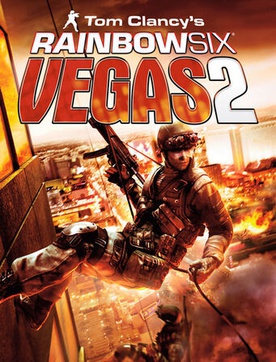
Tom Clancy's Rainbow Six: Vegas 2 is the seventh installment in the Rainbow Six series. It is a first-person shooter video game and the sequel to Tom Clancy's Rainbow Six: Vegas. It was announced by Ubisoft on November 20, 2007. The game was released for the Xbox 360 and PlayStation 3 in March 2008 The Microsoft Windows version, however, was delayed until April 2008. It was released in Japan on April 24, 2008, for the Xbox 360 and on May 29, 2008, for the PlayStation 3. This game is also available for Xbox One and Xbox Series X/S via backward compatibility.
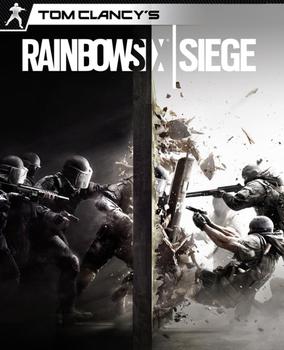
Tom Clancy's Rainbow Six Siege is an online tactical shooter video game developed by Ubisoft Montreal and published by Ubisoft. It was released worldwide for PlayStation 4, Windows, and Xbox One on December 1, 2015; the game was also released for PlayStation 5 and Xbox Series X/S exactly five years later on December 1, 2020. The title received a port for Google Stadia on June 30, 2021, and one for Amazon Luna in January 2022. The game puts heavy emphasis on environmental destruction and cooperation between players. Each player assumes control of an attacker or a defender in different gameplay modes such as rescuing a hostage, defusing a bomb, and taking control of an objective within a room. The title has no campaign but features a series of short, offline missions called, "situations" that can be played solo. These missions have a loose narrative, focusing on recruits going through training to prepare them for future encounters with the "White Masks", a terrorist group that threatens the safety of the world.

Wolfenstein: The Old Blood is an action-adventure first-person shooter video game developed by MachineGames and published by Bethesda Softworks. It was released on 5 May 2015 for PlayStation 4, Windows, and Xbox One. The game is a stand-alone title in the Wolfenstein series and a prequel expansion to 2014's Wolfenstein: The New Order, set in an alternate-history 1946. The single-player story follows war veteran William "B.J." Blazkowicz and his efforts to discover the locations of a Nazi compound. Development began in 2014, soon after the release of The New Order.


















